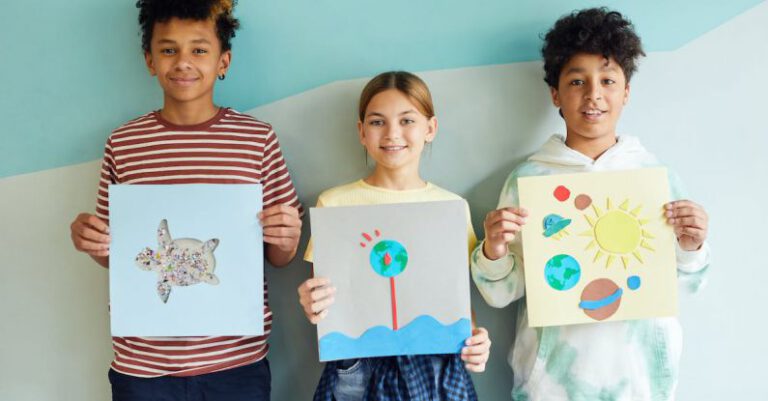How to Encourage Creativity in Children?
Encouraging Creativity in Children
Creativity is a vital skill that can benefit children in various aspects of their lives. From problem-solving to self-expression, fostering creativity in children can set them up for success in the future. As parents or educators, it is essential to provide opportunities and environments that nurture and encourage creativity in young minds. Here are some effective strategies to inspire and support creative thinking in children.
Create a Stimulating Environment
One of the first steps in encouraging creativity in children is to create a stimulating environment that sparks their imagination. Provide a space filled with art supplies, books, musical instruments, and other materials that can inspire creative exploration. Encourage open-ended play and allow children to experiment with different mediums and tools. A clutter-free and organized space can also help children focus on their creative endeavors without distractions.
Encourage Curiosity and Exploration
Curiosity is the driving force behind creativity. Encourage children to ask questions, explore new ideas, and seek out answers on their own. Foster a sense of wonder by exposing children to new experiences, places, and cultures. Encourage them to observe the world around them and notice the beauty in everyday things. By promoting curiosity, children will develop a thirst for knowledge and a willingness to think outside the box.
Embrace Mistakes and Failure
Creativity thrives in an environment where mistakes are seen as learning opportunities rather than failures. Encourage children to take risks and try new things, even if they might not succeed on the first try. Help them understand that making mistakes is a natural part of the creative process and that it is okay to fail sometimes. By embracing mistakes, children will become more resilient and willing to push the boundaries of their creativity.
Provide Time for Unstructured Play
In today’s fast-paced world, children are often overscheduled with activities and homework, leaving little time for unstructured play. Unstructured play is essential for allowing children to use their imagination and creativity freely. Encourage children to engage in imaginative play, whether it’s building forts, playing dress-up, or creating their own games. Unstructured play allows children to explore their interests, develop problem-solving skills, and unleash their creativity in a fun and relaxed setting.
Offer Positive Reinforcement and Encouragement
Positive reinforcement can go a long way in nurturing creativity in children. Praise their efforts and achievements, no matter how small, to boost their confidence and motivation. Encourage children to share their creative projects with others and celebrate their unique ideas and talents. By providing positive feedback and encouragement, children will feel supported in their creative pursuits and be more willing to take risks and try new things.
Engage in Creative Activities Together
As a parent or educator, you can also encourage creativity in children by engaging in creative activities together. Whether it’s painting, crafting, baking, or storytelling, participating in creative endeavors with children can inspire them and show them the joy of self-expression. Use these moments to bond with children, share ideas, and explore new ways of thinking. By modeling creativity and enthusiasm, you can help children develop a lifelong love for creative expression.
Foster a Growth Mindset
A growth mindset is essential for fostering creativity in children. Encourage children to view challenges as opportunities for growth and learning. Teach them that intelligence and creativity are not fixed traits but can be developed through effort and perseverance. Help children set goals, overcome obstacles, and learn from their experiences. By fostering a growth mindset, children will be more willing to take risks, explore new ideas, and push the boundaries of their creativity.
Incorporate Technology in Creative Ways
While it’s essential to provide children with hands-on experiences and tactile materials, technology can also be a valuable tool for fostering creativity. Encourage children to use digital tools for creative projects such as digital art, coding, music composition, and storytelling. Technology can provide children with new avenues for self-expression and creativity, allowing them to explore their interests in innovative ways. Embrace technology as a tool for creativity rather than a distraction, and encourage children to use it mindfully and purposefully.
Encourage Collaboration and Communication
Creativity often thrives in collaborative settings where ideas can be shared, discussed, and refined. Encourage children to work together on creative projects, solve problems as a team, and communicate their ideas effectively. Teach them the importance of listening to others, respecting different viewpoints, and building on each other’s ideas. Collaboration can help children develop social skills, empathy, and a deeper appreciation for the creative process.
Conclusion: Nurturing Creativity in Children
Encouraging creativity in children is a rewarding and fulfilling journey that can have a lasting impact on their development. By creating a stimulating environment, fostering curiosity and exploration, embracing mistakes, providing time for unstructured play, offering positive reinforcement, engaging in creative activities together, fostering a growth mindset, incorporating technology in creative ways, and encouraging collaboration and communication, parents and educators can empower children to think creatively, solve problems innovatively, and express themselves authentically. By nurturing creativity in children, we are helping them unleash their full potential and prepare them for a future where creativity is a valuable asset in every aspect of their lives.






